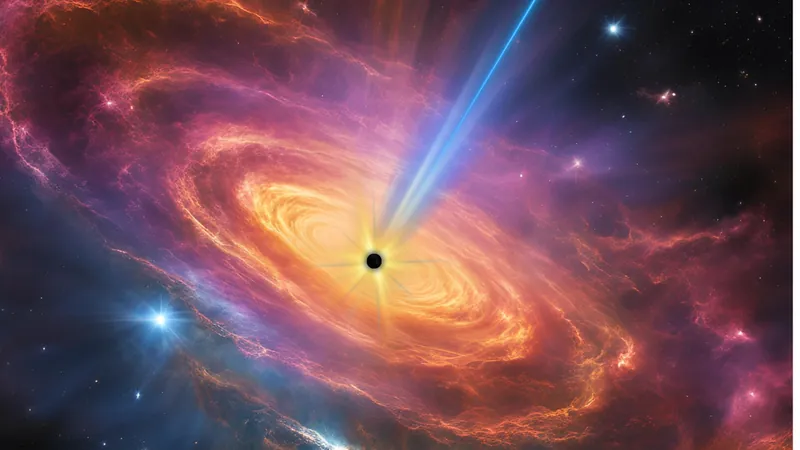
Did This Ancient Quasar Illuminate the Cosmic Dark Ages?
2025-01-17
Author: Siti
Introduction
Astronomers have recently announced a groundbreaking discovery of a supermassive black hole-powered quasar that could have played a pivotal role in 'turning on the lights' of the early universe, signaling the end of the cosmic dark ages nearly 13 billion years ago.
Observations from NuSTAR and Chandra
Using NASA's innovative NuSTAR (Nuclear Spectroscopic Telescope Array) X-ray space telescope, scientists observed the extraordinary brightening and dimming patterns of this quasar. The data from NuSTAR was further validated by findings from NASA's Chandra X-ray space telescope, revealing crucial insights into the early development of supermassive black holes.
Understanding Cosmic Dark Ages
These new insights may unravel longstanding mysteries regarding how the universe transitioned from its 'dark ages' to a more illuminated state, as well as how these massive black holes rapidly accumulated significant mass—equivalent to millions or even billions of suns—in a relatively brief cosmic timeframe.
Formation of Supermassive Black Holes
Supermassive black holes are speculated to grow in size through a series of mergers with smaller black holes and by consuming vast amounts of gas and dust. However, this process typically requires more than a billion years, presenting a significant challenge when considering black holes that existed less than a billion years after the Big Bang.
The Quasar J1429+5447
The quasar in question, designated CFHQS J142952+54471 (J1429+5447), is so distant that its light has taken nearly 13 billion years to reach Earth, placing it at the tail end of the cosmic dark ages. “This quasar is likely to be a supermassive black hole with a jet directed toward Earth, allowing us to glimpse it in the universe's formative first billion years," said Lea Marcotulli, a researcher at Yale University and leader of the study.
Mass and Epoch of Reionization
This quasar, with an estimated mass around 200 million times that of our sun, existed during a critical period known as the 'epoch of reionization.' The cosmic dark ages, which lasted until about 1.1 billion years post-Big Bang, were characterized by a lack of luminous celestial objects as the universe became increasingly opaque.
Transition from Dark Ages to Light
Around 380,000 years after the Big Bang, the universe cooled enough for electrons and protons to combine and form neutral hydrogen atoms. This marked a transition from a brightly lit universe (with light trapped by free electrons) to one that was dark and featureless. As more neutral hydrogen formed, it absorbed photons, leading to this gloomy period until energetic light sources began breaking down the hydrogen ions, allowing light to travel freely again during the epoch of reionization.
Role of Quasars in Reionization
While ultraviolet light from the first stars is often credited as the main driver of reionization, it has been hypothesized that other high-energy light sources were also significant contributors, which brings quasars like J1429+5447 into central focus.
The Nature of Quasars
Quasars are known to be supermassive black holes actively consuming massive amounts of surrounding material. This feeding process generates immense radiation and powerful jets that can emit energy surpassing that of all nearby stars combined. Their brightness makes them critical tools for studying epoch transitions like reionization, potentially ionizing neutral hydrogen that obscured light during the dark ages.
Recent Observations and Findings
Recent observations of J1429+5447 revealed unprecedented changes in its X-ray emissions, which doubled in just four months. This timescale, although short by cosmic standards, was further compressed by relativistic effects, as seen from Earth. Meg Urry of Yale’s Faculty of Arts and Sciences noted, “The jet travels at near-light speed, amplifying these intensity changes in a way that has never been observed before."
Implications of the Discovery
Ultimately, these findings may not only clarify the enigmatic processes behind cosmic reionization but could also lead to the discovery of more ancient supermassive black holes and offer insight into how they achieved such incredible mass in a fraction of the time predicted by current models. As researchers continue to explore these cosmic titans, the question arises: what role did these early quasars play in shaping our universe as we know it today?



 Brasil (PT)
Brasil (PT)
 Canada (EN)
Canada (EN)
 Chile (ES)
Chile (ES)
 Česko (CS)
Česko (CS)
 대한민국 (KO)
대한민국 (KO)
 España (ES)
España (ES)
 France (FR)
France (FR)
 Hong Kong (EN)
Hong Kong (EN)
 Italia (IT)
Italia (IT)
 日本 (JA)
日本 (JA)
 Magyarország (HU)
Magyarország (HU)
 Norge (NO)
Norge (NO)
 Polska (PL)
Polska (PL)
 Schweiz (DE)
Schweiz (DE)
 Singapore (EN)
Singapore (EN)
 Sverige (SV)
Sverige (SV)
 Suomi (FI)
Suomi (FI)
 Türkiye (TR)
Türkiye (TR)
 الإمارات العربية المتحدة (AR)
الإمارات العربية المتحدة (AR)